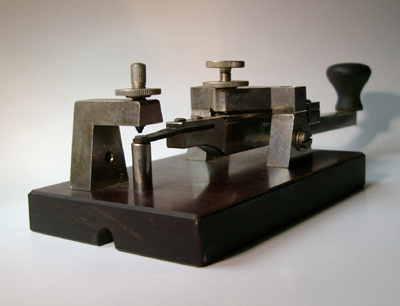Informationen zur Schweden Key |
THE SWEDISH MORSE KEY
The Swedish type key as we know it was designed by Anton Henric Öller in 1857 being issued Swedish patent No. 54 for his design.

Öller was the Telegraph Director of Stockholm having built the first telegraph line in Sweden using equipment from France and Germany.
He then left the service to set up a shop in Stockholm to build his own telegraph instruments from 1857 until his death.
He designed a heavy brass key, somewhat ornate according to the style of those days, where the
pivoted key arm ended in a short steel spring.
The spring, which held a silver button, moved between contacts on two sturdy brass stands.
The resulting softer action made keying much easier and saved professional telegraphers a common wrist ailment, the “Glass Arm”.
Öller obtained a patent for his design in 1857 and kept manufacturing these keys till his death in 1888.
Working for Öller was the later famous Lars M.Ericsson and two other master mechanics, John A.Lindholm and John L.Wikström.
The L.M.Ericsson company is today a telecommunications giant with branches all over the world. The parent company produced
large quantities of these keys, used by the inland telegraph nets, the railroads, the merchant marine (with a marble base instead of wooden) and the military, up till the start of World War II.
Lindholm and Wikström formed their own company in 1878 to make electric apparatus and also
produced a quantity of the Öller telegraph keys. These differ from the original design mostly in finish,
as the cast brass parts were only machined where it was necessary for looks or function.
In the early 1920:s, when the Swedish Telegraph Administration changed over their extensive inland
telegraph network from manual Morse code to teletype machines, a number of LM keys became surplus.
When World War II began, the Swedish military suddenly needed a lot of telegraph keys
and devised a simplified version of the LM key, easily produced.

In this wartime model “Swedish Key,”, the pivoting arm is replaced by a flat spring suspension, the back
contact is scrapped and replaced by a straight post but the spring steel extension is still retained.







